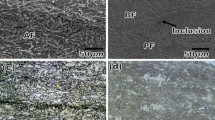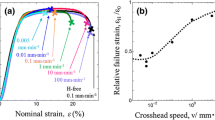Abstract
In this research, the efficacy of specific heat treatment procedures in mitigating hydrogen embrittlement in X100 pipeline steels is discussed. The studied steels underwent a one-step austenitization process at temperatures of 780 °C (HT1), 830 °(HT2), and 880 °C (HT3) for 90 min, followed by oil quenching, tempering at 600 °C, and air cooling. The susceptibility of both the heat-treated and as-received (REF) specimens to HIC was assessed using an electrochemical hydrogen charging, tensile testing, micro-hardness testing, and electron backscatter diffraction (EBSD) techniques. The results showed that an increase in annealing temperature from 780 to 880 °C considerably decreases hydrogen embrittlement susceptibility. The hardness value at the centerline of the as-received (REF) specimen was found to be higher than that of the heat-treated specimens. Additionally, calculations of the hydrogen embrittlement (HE) index for all specimens were conducted. The results show that the REF specimen, which demonstrated the highest hardness and HE index values, has greater susceptibility to HIC. Conversely, the HT3 specimen, which was annealed at 880 °C and displayed the lowest hardness and HE index values, showed commendable resistance to HIC. The EBSD analysis revealed a decrease in Kernel average misorientation (KAM) values in heat-treated specimens, with the lowest values found in HT3. Dominant textures in all studied steels, {011} and {111}, were considered HIC-resistant and recrystallization map** indicated a peak area of recrystallized grains in the REF specimen.











Similar content being viewed by others
Data Availability
Data will be made available on request.
References
D.C.S. Garcia, R.N. Carvalho, V.F.C. Lins, D.M. Rezende, D.S. Dos Santos, Influence of microstructure in the hydrogen permeation in martensitic-ferritic stainless steel. Int. J. Hydrogen Energy. 40, 17102–17109 (2015). https://doi.org/10.1016/j.ijhydene.2015.06.102
L. Gan, F. Huang, X. Zhao, J. Liu, Y.F. Cheng, Hydrogen trap** and hydrogen induced cracking of welded X100 pipeline steel in H2S environments. Int. J. Hydrogen Energy. 43, 2293–2306 (2018). https://doi.org/10.1016/j.ijhydene.2017.11.155
F. Huang, S. Liu, J. Liu, K.G. Zhang, T.H. **, Sulfide stress cracking resistance of the welded WDL690D HSLA steel in H2S environment. Mater. Sci. Eng. A. 591, 159–166 (2014). https://doi.org/10.1016/j.msea.2013.10.081
Y. Sun, Y. Frank Cheng, Hydrogen-induced degradation of high-strength steel pipeline welds: a critical review. Eng. Fail. Anal. 133, 105985 (2022). https://doi.org/10.1016/j.engfailanal.2021.105985
K.M. Mostafijur Rahman, M.A. Mohtadi-Bonab, R. Ouellet, J. Szpunar, N. Zhu, Effect of electrochemical hydrogen charging on an API X70 pipeline steel with focus on characterization of inclusions. Int. J. Press. Vessel. Pip. 173, 147–155 (2019). https://doi.org/10.1016/j.ijpvp.2019.05.006
Y.D. Han, R.Z. Wang, H.Y. **g, L. Zhao, L.Y. Xu, P. **n, Sulphide stress cracking behaviour of the coarse-grained heat-affected zone in X100 pipeline steel under different heat inputs. Int. J. Hydrogen Energy. 45, 20094–20105 (2020). https://doi.org/10.1016/j.ijhydene.2020.05.092
H. Fu, X. Chen, W. Wang, G. Pia, J. Zhang, J. Li, Statistical study on the effects of heterogeneous deformation and grain boundary character on hydrogen-induced crack initiation and propagation in twining-induced plasticity steels. Corros. Sci. 192, 109796 (2021). https://doi.org/10.1016/j.corsci.2021.109796
M.F.G. Ramirez, J.W.C. Hernández, D.H. Ladino, M. Masoumi, H. Goldenstein, Effects of different cooling rates on the microstructure, crystallographic features, and hydrogen induced cracking of API X80 pipeline steel. J. Mater. Res. Technol. 14, 1848–1861 (2021). https://doi.org/10.1016/j.jmrt.2021.07.060
J.L. González-Velázquez, E. Entezari, On the assessment of non-metallic inclusions by part 13 of API 579–1/ASME FFS-1 2016. Procedia Struct Integr. 33, 221–228 (2021). https://doi.org/10.1016/j.prostr.2021.10.027
A.S. Tetelman, W.D. Robertson, The mechanism of hydrogen embrittlement observed in iron-silicon single crystals. Trans. TMS-AIME. 224, 775–783 (1962)
T.Y. **, Z.Y. Liu, Y.F. Cheng, Effect of non-metallic inclusions on hydrogen-induced cracking of API5L X100 steel. Int. J. Hydrogen Energy. 35, 8014–8021 (2010). https://doi.org/10.1016/j.ijhydene.2010.05.089
K.M.M. Rahman, M.A. Mohtadi-Bonab, R. Ouellet, J. Szpunar, A comparative study of the role of hydrogen on degradation of the mechanical properties of API X60, X60SS, and X70 pipeline steels. Steel Res. Int. 90, 1900078 (2019)
A. Mustapha, E.A. Charles, D. Hardie, Evaluation of environment-assisted cracking susceptibility of a grade X100 pipeline steel. Corros. Sci. 54, 5–9 (2012). https://doi.org/10.1016/j.corsci.2011.08.030
D. Pérez Escobar, C. Miñambres, L. Duprez, K. Verbeken, M. Verhaege, Internal and surface damage of multiphase steels and pure iron after electrochemical hydrogen charging. Corros. Sci. 53, 3166–3176 (2011). https://doi.org/10.1016/j.corsci.2011.05.060
G. Krauss, Martensite in steel: strength and structure. Mater. Sci. Eng. A. 273–275, 40–57 (1999). https://doi.org/10.1016/S0921-5093(99)00288-9
E. Entezari, H. Mousalou, S. Yazdani, J.L. González-Velázquez, J.A. Szpunar, The evaluation of quenching temperature effect on microstructural and mechanical properties of advanced high strength low carbon steel after quenching partitioning treatment. Procedia Struct. Integr. 37, 145–152 (2022). https://doi.org/10.1016/j.prostr.2022.01.070
G. Wang, Y. Yan, J. Li, J. Huang, L. Qiao, A.A. Volinsky, Microstructure effect on hydrogen-induced cracking in TM210 maraging steel. Mater. Sci. Eng. A. 586, 142–148 (2013). https://doi.org/10.1016/j.msea.2013.07.097
E. Entezari, J.L. González-Velázquez, D.R. López, M.A.B. Zúñiga, J.A. Szpunar, Review of current developments on high strength pipeline steels for HIC inducing service. Frat. Ed Integr. Strutt. 16, 20–45 (2022)
M.A. Smirnov, I.Y. Pyshmintsev, A.N. Maltseva, O.V. Mushina, Effect of ferrite-bainite structure on the properties of high-strength pipe steel. Metallurgist. 56, 43–51 (2012). https://doi.org/10.1007/s11015-012-9534-7
E. Entezari, B. Avishan, H. Mousalou, S. Yazdani, Effect of electro slag remelting (ESR) on the microstructure and mechanical properties of low carbon bainitic steel. Kov. Mater. 56, 253–263 (2018)
R. Pourazizi, R.K. Zadeh Davani, M.A. Mohtadi-Bonab, J.A. Szpunar, Evolution of microstructure and texture in pipeline steels at different TMCP procedures with regard to hydrogen induced cracking. Int. J. Hydrogen Energy. 46, 38741–38754 (2021). https://doi.org/10.1016/j.ijhydene.2021.08.232
M. Masoumi, C.C. Silva, M. Béreš, D.H. Ladino, H.F.G. de Abreu, Role of crystallographic texture on the improvement of hydrogen-induced crack resistance in API 5L X70 pipeline steel. Int. J. Hydrogen Energy. 42, 1318–1326 (2017). https://doi.org/10.1016/j.ijhydene.2016.10.124
M. Masoumi, C.C. Silva, H.F.G. de Abreu, Effect of crystallographic orientations on the hydrogen-induced cracking resistance improvement of API 5L X70 pipeline steel under various thermomechanical processing, Corros. Sci. 111 (2016) 121–131. https://doi.org/10.1016/j.corsci.2016.05.003.
C.C. Koch, Optimization of strength and ductility in nanocrystalline and ultrafine grained metals, Scr. Mater. 49 (2003) 657–662. https://doi.org/10.1016/S1359-6462(03)00394-4.
M. Loidl, O. Kolk, S. Veith, G. T., Characterization of hydrogen embrittlement in automotive advanced high strength steels. Materwiss. Werksttech. 42, 1105–1110 (2011). https://doi.org/10.1002/mawe.201100917
R. Khatib Zadeh Davani, M.A. Mohtadi-Bonab, S. Yadav, E. Entezari, J.F.A. Cabezas, J. Szpunar, Effect of quench tempering on hydrogen embrittlement and corrosion behavior of X100 pipeline steel. Metals (Basel). 13, 841 (2023)
D. Broek, The role of inclusions in ductile fracture and fracture toughness. Eng. Fract. Mech. 5, 55–66 (1973)
M.A. Mohtadi-Bonab, M. Masoumi, J.A. Szpunar, A comparative fracture analysis on as-received and electrochemically hydrogen charged API X60 and API X60SS pipeline steels subjected to tensile testing. Eng. Fail. Anal. 129, 105721 (2021). https://doi.org/10.1016/j.engfailanal.2021.105721
M.A. Mohtadi-Bonab, M. Masoumi, J.A. Szpunar, Failure analysis in API X70 pipeline steel in sour environment with an emphasis on fracture surfaces and crack propagation. Int. J. Press. Vessel. Pip. 195, 104600 (2022). https://doi.org/10.1016/j.ijpvp.2021.104600
M.A. Mohtadi-Bonab, H. Mousavi, R. Pourazizi, J.A. Szpunar, Finite element modeling of HIC propagation in pipeline steel with regard to experimental observations. Int. J. Hydrogen Energy. 45, 23122–23133 (2020). https://doi.org/10.1016/j.ijhydene.2020.06.054
J. Moon, C. Park, S.-J. Kim, Influence of Ti addition on the hydrogen induced cracking of API 5L X70 hot-rolled pipeline steel in acid sour media. Met. Mater. Int. 18, 613–617 (2012). https://doi.org/10.1007/s12540-012-4007-x
J. Moon, S.-J. Kim, C. Lee, Role of Ca treatment in hydrogen induced cracking of hot rolled API pipeline steel in acid sour media. Met. Mater. Int. 19, 45–48 (2013). https://doi.org/10.1007/s12540-013-1008-3
J.H. Park, M. Oh, S.J. Kim, Effect of bainite in microstructure on hydrogen diffusion and trap** behavior of ferritic steel used for sour service application. J. Mater. Res. 32, 1295–1303 (2017). https://doi.org/10.1557/jmr.2016.480
C.A. Zapffe, C.E. Sims, Hydrogen embrittlement, internal stress and defects in steel. Trans. Aime. 145, 225–271 (1941)
W. Qin, A. Thomas, Z.Q. Cheng, D. Gu, T.L. Li, W.L. Zhu, J.A. Szpunar, Key factors affecting hydrogen trap** at the inclusions in steels: a combined study using microprint technique and theoretical modeling. Corros. Sci. 200, 110239 (2022). https://doi.org/10.1016/j.corsci.2022.110239
Q. Wen, F. Huang, H. **ao, Y. Xu, Q. Hu, J. Liu, Improving hydrogen induced cracking resistance of high strength acid-resistant submarine pipeline steels via trace-Mg treatment. Int. J. Hydrogen Energy. 48, 14808–14821 (2023). https://doi.org/10.1016/j.ijhydene.2022.12.322
J.L. González Velázquez, E. Entezari, D.R. López, M.A. Beltrán Zúñiga, J. Szpunar, Experimental and in-service observations of HIC nucleation and growth in pipeline steel, in: 2022. https://doi.org/10.1115/QNDE2022-97160
R. Khatib Zadeh Davani, E.G. Ohaeri, S. Yadav, J.A. Szpunar, J. Su, M. Gaudet, M. Rashid, M. Arafin, Crystallographic texture and the mechanical properties of API 5L X70 pipeline steel designated for an arctic environment. Mater. Sci. Eng. A 889, 145849 (2024). https://doi.org/10.1016/j.msea.2023.145849
E. Entezari, J. Luis González Velázquez, D.R. López, M.A. Beltrán Zúñiga, H. Mousavi, R. Khatib Zadeh Davani, J. Szpunar, An experimental and statistical study on the characteristics of non-metallic inclusions that serve as hydrogen-induced crack nucleation sites in pipeline steel. Eng. Fail. Anal. 154, 107695 (2023). https://doi.org/10.1016/j.engfailanal.2023.107695
E. Entezari, J. Luis González Velázquez, M.A. Mohtadi-Bonab, D.R. López, M.A. Beltrán Zúñiga, R. Khatib Zadeh Davani, J. Szpunar, Experimental observations of nucleation and crack growth paths of hydrogen-induced cracking in pipeline steel. Eng. Fail. Anal. 154, 107650 (2023). https://doi.org/10.1016/j.engfailanal.2023.107650
Acknowledgment
The authors gratefully acknowledge the University of Saskatchewan for their considerable financial support.
Author information
Authors and Affiliations
Corresponding author
Ethics declarations
Conflict of interest
The authors declare that they have no known competing financial interests or personal relationships that could have appeared to influence the work reported in this paper.
Additional information
Publisher's Note
Springer Nature remains neutral with regard to jurisdictional claims in published maps and institutional affiliations.
Rights and permissions
Springer Nature or its licensor (e.g. a society or other partner) holds exclusive rights to this article under a publishing agreement with the author(s) or other rightsholder(s); author self-archiving of the accepted manuscript version of this article is solely governed by the terms of such publishing agreement and applicable law.
About this article
Cite this article
Davani, R.K.Z., Entezari, E., Mohtadi-Bonab, M.A. et al. Effect of Electrochemical Hydrogen Charging on Hydrogen Embrittlement and Mechanical Properties of Quenched Tempered X100 Pipeline Steel. J Fail. Anal. and Preven. 24, 318–330 (2024). https://doi.org/10.1007/s11668-023-01841-2
Received:
Revised:
Accepted:
Published:
Issue Date:
DOI: https://doi.org/10.1007/s11668-023-01841-2




